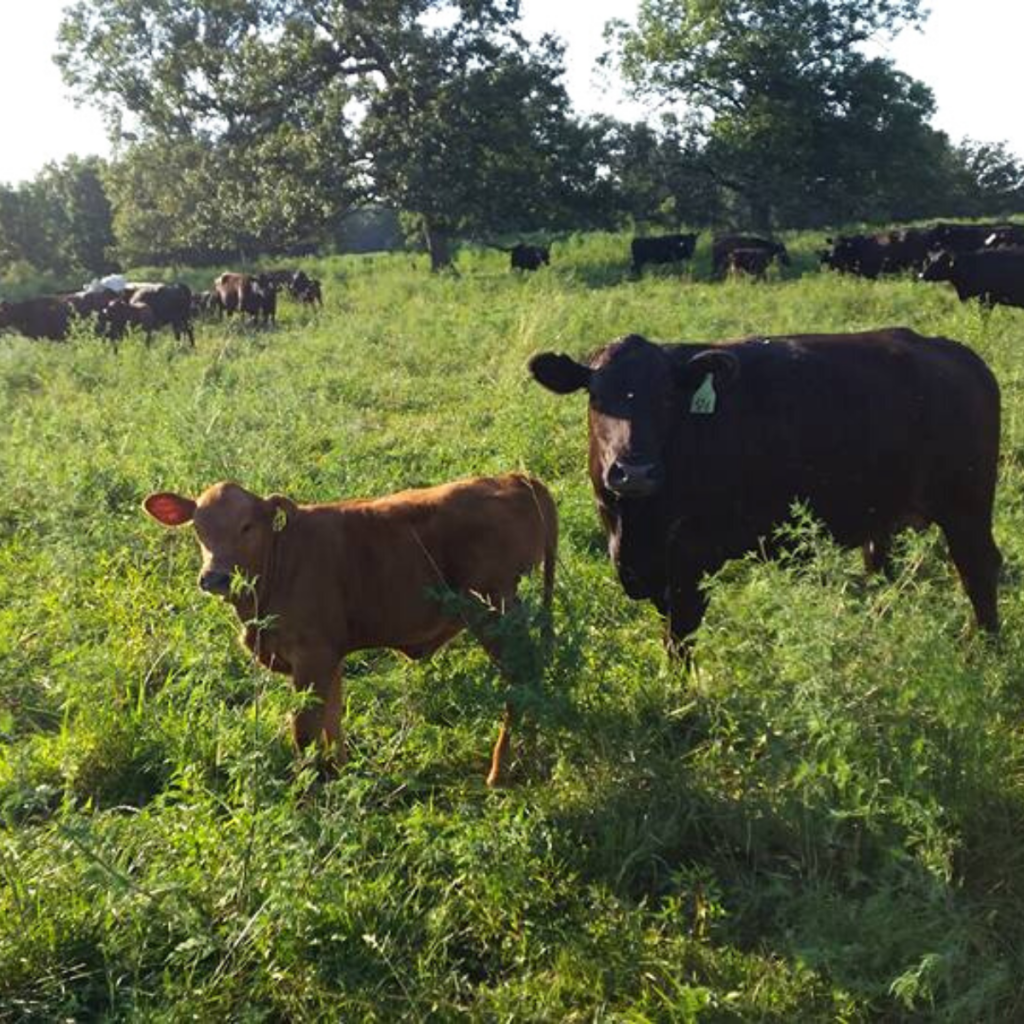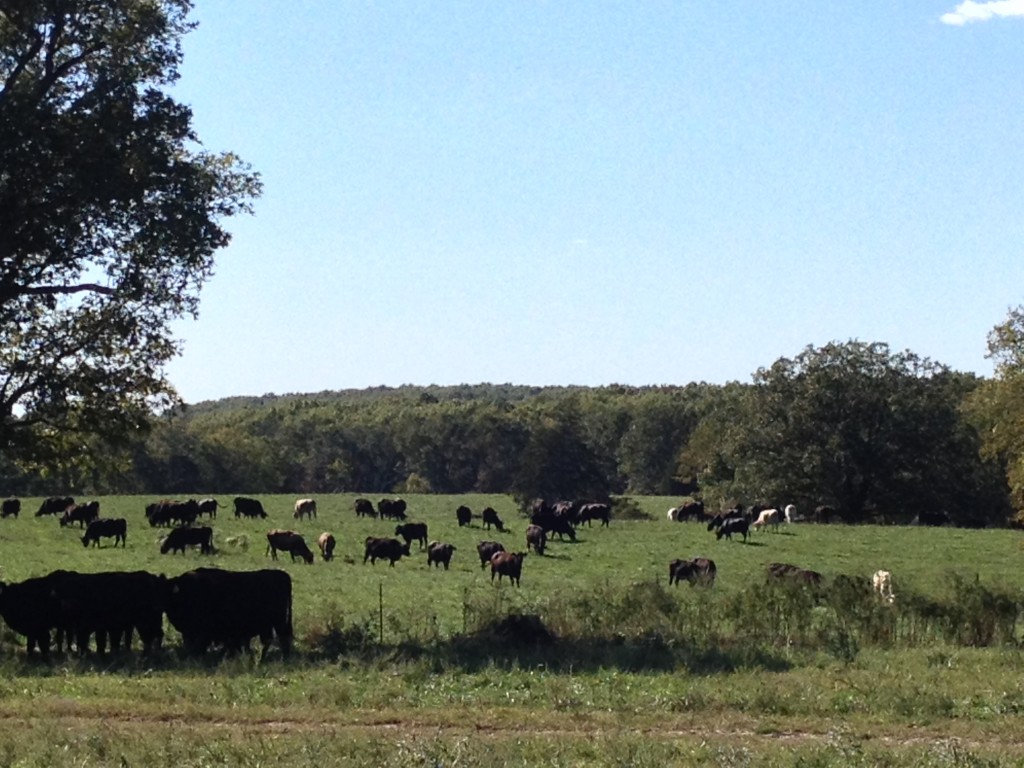
If your new to the cattle world, you may think that the term “cow” covers all the animals on our farm. But, there’s actually a huge difference between a steer vs bull, and a cow vs heifer.
Cattle Terminology
If you’re not up-to-speed on the difference between bull and steer, or cow and heifer, here’s some basic cattle terminology. We go into much more detail below.
- Bovine: An animal in the cattle group, which includes bison and buffaloes
- Cow: A cow is a female bovine that has had at least one calf. Cows have udders. Using everyday lingo, the cows are the “moms”
- Heifer: A heifer is a young female animal that has not had her first calf yet. Once a heifer has a calf, she automatically becomes a cow. In other words, heifers are like “first-time moms”
- Bred Heifer: A female bovine that is pregnant with her first calf.
- Bull: A mature male bovine that is fertile and is used for breeding. An adult bull will have its genitals intact with a scrotum and testicles. One bull can breed about 25 cows. Bulls exhibit more aggressive behavior and dominant overall (compared to steers). The bulls are the “dads.”
- Steer: A steer is a male animal that belongs to the cattle family and has been castrated. His testicles have been removed, and he is incapable of reproducing. Castration is most commonly done before sexual maturity when the bull is a young calf.
How to tell the difference between bull and steer, cow and heifer?
If you’re trying to figure out the difference between a bull and steer, cow or heifer, look at the side view near the hind legs. If you look between the animal’s back legs, you’ll see that cows have udders and bulls have scrotum. Steers will not have testes like bulls. Heifers have teats, but no visible udder like cows do.
Cattle farmers also use ear tags to help quickly distinguish the type of bovine. On our farm, ear tags in the calf’s left ear mean it’s a heifer (girl) and in the right ear means it’s a steer (boy).
What are the different types of cattle breeds
There are more than 250 cattle breeds around the world. The U.S. has about 80 different breeds. Of these, the most common U.S. beef cattle breeds are Angus, Charolais, Hereford, Simmentals and Brahmas. The most popular beef breed in the U.S. is Angus, and there are two types: Red Angus and Black Angus.
Contrary to some myths, you can’t determine if an animal is a bull or cow based on its color or if it has horns or not. A bovine’s breed, not its gender, determines its color. For instance, Angus cattle are typically black, Jersey cattle are brown and Holsteins are black and white.
From farm to plate: How long does raising beef cattle take?
Many people are surprised at the period of time it takes for a calf to become beef on their dinner plate. To give you an idea of the whole timeline, if we breed a cow in the Summer of 2023, it will give birth in the Spring of 2024. The calf will be weaned in the Fall of 2024, and then it eats grass and grows for 12-16 months. When it is around 1100 lbs, we will take it to a USDA certified butcher for slaughter and packaging. It will be ready to be delivered to a customer’s door as finished beef in the Winter of 2025.
As you can see, it takes almost 3 years from conception to a steak.
Hopefully, this helps explain why all farmers have a limited quantity of beef to sell. We’re guesstimating 12+ months out how much beef buyers will want to purchase the following year. 🙂
So, what do you usually eat when you eat meat? Generally speaking, if it’s good quality meat it’s usually a heifer or steer. If it’s lower quality meat, it’s usually a cow.
Now that you know the very basic definitions, let’s go a little deeper on the differences between steer vs bull and cow vs heifer.
Cow-Calf Farm (a.k.a. Cow-calf operation)
Our farm is what’s known as a cow-calf farm. This term may be new to you, but it’s a very common term in the agriculture community and it’s a typical cattle farm in the United States that raises beef cows.
In the U.S., the beef industry is primarily made up of cow-calf farms. Usually, farmers own about 10-100 cows. In Missouri, the average herd size is 27 mama cows. We’re a fifth-generation farm, so our herd is larger than the average since we’ve been doing this a long time.
So, what does “cow-calf farm” mean? It means the farmer owns a herd of cows (remember, cows are the moms), and each cow is expected to have a baby calf every year.
The key to a cow-calf farm is conception. We want every cow to have a calf every year. Then, we sell the calf for income. Keep in mind, that it’s ideal for a calf to be born every year, but there are always lots of variables (more on that later).
If you’re wondering where we sell the calf, every farm is little different on this. On our farm, we typically do one of three things with the calf. We either 1) sell them to a cattle sale barn (and then another farmer buys them and raises them until they can be butchered for beef), 2) keep them for future Clover Meadows Beef sales, or 3) keep them to be future breeding cows (the Mom cows) at our farm.

Cows and Heifers (the moms)
As we mentioned above, a cow is a female animal that has had at least one calf. Using everyday human-terms, cows are “moms.” A heifer is a female animal that has never had a calf. Once a heifer has a calf, she automatically becomes a cow.
When looking at their external appearance, cows are typically smoother from the head all the way down to the tailhead, with no muscular crest at the shoulders and not as much muscling around the hips (like bulls).
Cows are a lot like people in that they have a 9-month gestation period, and some cows get pregnant regularly and others not-so-often. A “good cow” is one that has a healthy calf every year.
When a calf is about six-months old, it weighs about 500 lbs. From zero to six months, calves drink their mother’s milk. At six-months of age, we wean the calf from the mother’s milk and they start to eat grass. The reason for this is because at six-months the calf is able to effectively convert grass to nutrients (more on this below).
The calves (the babies)
Calves on our farm are born in the spring and fall. If a calf is a female, it’s called a heifer. If it’s a male, it’s called a bull calf or steer.
One of the many reasons all of our calves are born in the spring and fall is for the for the protection of the cow and calf. Usually, cows give birth outside in a field and no one is nearby when they have the calf. Birthing conditions are much better for mom and baby in spring and fall, when it’s not too hot or too cold.
The calves stay with their moms for about six months, and then they’re weaned. There are two big reasons this happens at six months of age. First, at six months the mother no longer produces milk. Second, at the beginning of a calf’s life he needs his mother’s milk for nutrients. However, as he grows, he slowly starts to get more nutrients from the grass verses milk. At 6 months, the calf can convert grass to nutrients, and he will grow and gain muscle from the grass’s nutrients.
On our farm, once the calf is about six months, we have to make a decision on our next step and it’s typically one of three paths. We can either 1) sell them to a cattle sale barn, 2) keep them for future Clover Meadows Beef sales, or 3) keep them to be future breeding cows (the Mom cows) at our farm.
Our best calves are hand-picked to be Clover Meadows Beef, which is the beef we sell as quarter, half and whole beef. These calves will spend the next 12 to 16 months on grass until they are around 1100 lbs. At that time, they’re ready to go to slaughter, and become the protein packed, lean grass-fed Clover Meadows Beef that our customers know and love.
Steers
In the definitions above, we talked about the difference between bull and steer. A newly born male calf is a bull calf. Typically, between three and six months of age, a bull calf is neutered and then it is known as a steer. By definition, a steer is a male animal that has been neutered.
We’ve been asked lots of questions on why farmers castrate bull calves. The primary reason is because bull calves have a temper and aggressive behavior. They like to fight each other to establish dominance. This makes them very difficult to handle on a farm.
Another big reason is because lower levels of testosterone in beef leads to higher quality grades and more consistent tenderness and marbling in beef. When testosterone is present in bull meat, the beef’s taste and flavor changes and becomes more gamey.
Most steers are raised for beef production. Beef cattle, such as Hereford and Angus breeds, have been bred to produce muscle, not milk, like Holstein dairy cows. Different beef cattle breeds have differing characteristics related to growth rate, fat content of the meat, and disease resistance.
Bulls (the dads)
Perhaps the biggest difference between a bull and steer is when it comes to breeding. Bulls have a very specific job and it comes around two times a year – when we let them in the field with the cows. ‘Nuff said!
Bulls are usually larger than other cattle. They have large, muscular shoulders, necks and hindquarters. A hump is usually noticeable on its shoulders. Most will have a large, blocky appearance, with their front and hind legs wider apart than cows. A bull’s weight can be as much as 2,000 pounds when full grown. One bull can breed about 25 cows.
When they aren’t breading, they’re in their own pasture and enjoying roaming fields and eating grass.
There are lots of interesting facts about bulls that we find fascinating. For example, there is a difference in feeding behavior between bulls and steers that scientists believe is related to higher levels of testosterone and appetite-related hormones in bulls.
Another interesting fact is that scientific studies have shown that the bull will follow a cow in heat for about 10-miles. This is their “dating” process. A bull smells the cows urine to determine if she is ready to breed.
Also, 65% of the genetic makeup of a calf comes from the bull, not the cow. Therefore, if we want a calf that has leaner meat, we will let a leaner bull be in the field with those cows.
Like many cow-calf operations, we buy our bulls from someone that specializes in bulls. We’ve written about buying a bull and shown a bull auction in previous posts. We could raise our own bulls on the farm (after all, some of the calves born on are farm are male), but we choose not to.
Conclusion
Do you want to learn more about beef? Join our weekly e-newsletter where we share farm happenings, recipes and beef availability. Sign-up and get a cheat sheet with 9-must-ask questions before buying beef directly from a farmer. Or, we have an entire ebook about beef that goes through purchasing and preparing beef from a cattle farmers perspective.
Here are a few other links you may like:


So, then what do you call the male if he is not neutered and before he is mature? A baby bull?
Hi Karen, Thanks for your question. It sounds like you’re talking about dairy cows, not beef cows. Calves of dairy cows are usually separated from their mothers earlier than beef calves. Our (beef) calves stay with their mothers until they’re approximately 6-8 months. At that time, we wean them by putting the calves in a different field from their mothers so that the calves will start to eat grass. Here’s a post that gives even more details about how we raise our cows and calves: http://www.clovervalleybeef.com/raising-grass-fed-beef/ (P.S. We do have friends that raise dairy cows, and we know that their calves are never harmed either. We’re definitely not experts in dairy calves, but if you have more questions about them we can try and find you answers.)
I have a question. I’m on a lot of vegan sites and they say that to have a cow give milk the farmer either drags the newborn calf to a veal cage or kills it. Is this true?
I have a question. I’m on a lot of vegan sites and they say that to have a cow give milk the farmer either drags the newborn bull cow to a veal cage or kills it. Is this true?
Thanks for the information .
Good question. It’s called a bull calf.
So what do you call immature, un-neutered male cattle? A male calf?